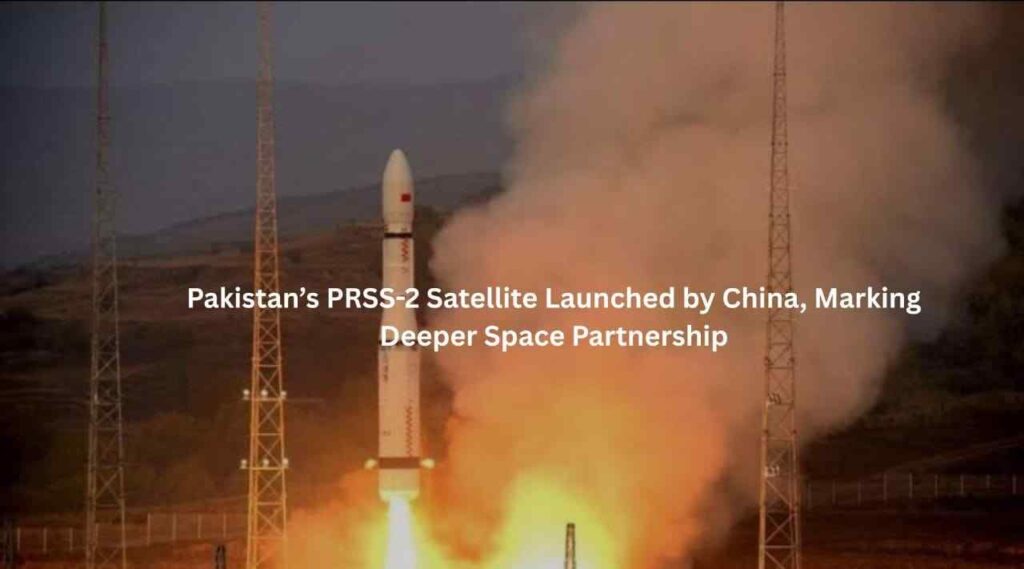China Helps Pakistan Launch New Remote Sensing Satellite — Strengthening Space Cooperation

By TOI World Desk | October 19, 2025
In another big leap for international space cooperation, China and Pakistan have once again joined hands to send a new satellite into orbit. The Pakistan Remote Sensing Satellite-2 (PRSS-2) was successfully launched on Saturday from a commercial aerospace innovation zone in northwest China, marking yet another proud milestone in Pakistan’s growing space journey.
The satellite lifted off aboard a Lijian-1 Y8 rocket, alongside two Chinese satellites — AIRSAT-03 and AIRSAT-04. According to China’s state media, all three satellites were smoothly placed into their designated orbits, signaling another successful mission for both countries’ expanding partnership in outer space.
What Exactly Is a Remote Sensing Satellite?
A remote sensing satellite is basically an eye in the sky — one that doesn’t just capture pretty pictures of Earth, but collects valuable information about our planet. Using high-resolution cameras and scientific sensors, these satellites can detect and measure everything from forest fires to ocean temperatures.
Here are just a few things satellites like PRSS-2 can do:
- Track forest fires and monitor their spread in real time
- Measure temperature changes in oceans and the atmosphere
- Map cloud patterns and weather systems
- Observe urban growth, farmland, and deforestation
- Study volcanoes, earthquakes, and topographical changes
- Even help chart the depth and shape of the ocean floor
This kind of satellite data is crucial for climate science, disaster management, and environmental planning. Governments and research bodies across the world — including NASA and the US Geological Survey (USGS) — depend heavily on such data to track how our planet is evolving.
A Strong and Steady Partnership in Space
The successful PRSS-2 launch is more than just a technical success — it’s a symbol of deepening trust and collaboration between China and Pakistan in science and technology.
2025 has already been a busy year for Pakistan’s space ambitions. Earlier this year, the country launched two other satellites — PRSS-1 in July and PRSC-EO1 in January — all with Chinese support.
China’s role goes far beyond launching rockets. It has provided technical expertise, training programs, and technology transfer, helping Pakistan strengthen its own space infrastructure and build local capabilities.
This partnership isn’t new. It dates back several years:
- In 2018, China helped Pakistan launch its first optical remote sensing satellite, PRSS-1, along with PakTES-1A, an Earth observation satellite designed domestically by Pakistani engineers.
- In 2024, China supported Pakistan in deploying a multi-mission communication satellite, boosting the country’s connectivity and broadcasting capacity.
Why This Matters
Space is no longer just about exploration — it’s about data, security, and development. For a developing country like Pakistan, access to space technology means access to information sovereignty, scientific progress, and economic growth.
Remote sensing satellites like PRSS-2 play an important role in:
- Improving agriculture by monitoring soil, crops, and water resources
- Enhancing disaster management, predicting floods or droughts earlier
- Tracking environmental changes like melting glaciers or desert expansion
- Strengthening border security and national infrastructure monitoring
China’s consistent support shows how space cooperation can become a bridge for innovation, trust, and mutual benefit between nations.
Looking Toward the Future
Experts believe this is just the beginning. The China–Pakistan space partnership is likely to grow even further in the coming years, possibly including:
- Next-generation communication satellites
- Advanced Earth observation systems
- Joint scientific research missions
- And even deep-space exploration projects
For Pakistan, PRSS-2 represents more than a satellite — it’s a step toward becoming an active player in the global space economy, using science and technology for sustainable growth, resilience, and innovation.
And for China, it’s another chance to show the world how partnerships can lift developing nations toward the stars. 🌠